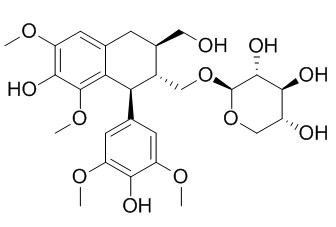Lyoniside
Lyoniside and saracoside are cytotoxic to promastigotes and intracellular amastigotes, they demonstrate strong anti-leishmanial efficacies in BALB/c mice model of leishmaniasis, suggests that these two compounds potential anti-leishmanial candidates. The synergistic action of lyoniside and triterpene acids was demonstrated in inhibitory effect exerted on germination and growth of Pinus sylvestris.
Inquire / Order:
manager@chemfaces.com
Technical Inquiries:
service@chemfaces.com
Tel:
+86-27-84237783
Fax:
+86-27-84254680
Address:
1 Building, No. 83, CheCheng Rd., Wuhan Economic and Technological Development Zone, Wuhan, Hubei 430056, PRC
Providing storage is as stated on the product vial and the vial is kept tightly sealed, the product can be stored for up to
24 months(2-8C).
Wherever possible, you should prepare and use solutions on the same day. However, if you need to make up stock solutions in advance, we recommend that you store the solution as aliquots in tightly sealed vials at -20C. Generally, these will be useable for up to two weeks. Before use, and prior to opening the vial we recommend that you allow your product to equilibrate to room temperature for at least 1 hour.
Need more advice on solubility, usage and handling? Please email to: service@chemfaces.com
The packaging of the product may have turned upside down during transportation, resulting in the natural compounds adhering to the neck or cap of the vial. take the vial out of its packaging and gently shake to let the compounds fall to the bottom of the vial. for liquid products, centrifuge at 200-500 RPM to gather the liquid at the bottom of the vial. try to avoid loss or contamination during handling.
Int J Mol Sci.2017, 19(1)
J Ethnopharmacol.2020, 249:112381
LWT2020, 126:109313
Institute of Food Science & Technology2021, 45(9).
J. Traditional Thai Medical Res. 2022,8(1):1-14.
Phytomedicine.2015, 22(11):1027-36
PLoS One.2018, 13(4):e0195642
Hindawi J of Food Biochemistry2023, P17:8883860
Toxicol In Vitro.2022, 81:105346.
J Am Soc Mass Spectrom.2021, 32(9):2451-2462.
Related and Featured Products
Phytochem. Lett., 2011, 4(2):138-43.
Isolation and biological activities of lyoniside from rhizomes and stems of Vaccinium myrtillus.[Reference:
WebLink]
A lignan glycoside identified as Lyoniside (9-O-β-d-xylopyranosyl(+)lyoniresinol) was obtained from ethanol extracts of the rhizomes and stems of bilberry (Vaccinium myrtillus L.), on a preparative scale, by droplet counter-current chromatography. The application of this method permitted the isolation of a pure substance in only one chromatographical step.
METHODS AND RESULTS:
The occurrence of Lyoniside in bilberry is reported for the first time. Seasonal fluctuations in the content of this compound in plant organs were demonstrated showing its highest levels in bilberry rhizomes and stems during the winter and their subsequent decrease in the spring. In vitro, the purified Lyoniside was evaluated for antioxidant, allelopathic and antifungal activities. It showed significant radical scavenging properties in a 2,2-diphenyl-1-picrylhydrazyl (DPPH) assay with IC50 of 23 μg ml−1. Applied at concentration of 10 μg ml−1, it suppressed by 75% the seedling radical growth of Lactuca sativa and Lepidium sativum, and exerted strong inhibitory effect (55%) on germination of Larix decidua. Moreover, the synergistic action of Lyoniside and triterpene acids was demonstrated in inhibitory effect exerted on germination and growth of Pinus sylvestris.
CONCLUSIONS:
Among 5 tested fungi strains of Ascomycota, the highest susceptibility was shown by Fusarium oxysporum and Mucor hiemalis, with mycelial growth inhibited by Lyoniside concentration of 50 μg ml−1 by 78 and 80%, respectively.
Biochem Pharmacol. 2013 Dec 15;86(12):1673-87.
The lignan glycosides lyoniside and saracoside poison the unusual type IB topoisomerase of Leishmania donovani and kill the parasite both in vitro and in vivo.[Pubmed:
24134912]
Lignans are diphenyl propanoids with vast range of biological activities. The present study provides an important insight into the anti-leishmanial activities of two lignan glycosides, viz. Lyoniside and saracoside.
METHODS AND RESULTS:
These compounds inhibit catalytic activities of topoisomerase IB (LdTopIB) of Leishmania donovani in non-competitive manner and stabilize the LdTopIB mediated cleavage complex formation both in vitro and in Leishmania promastigotes and subsequently inhibit the religation of cleaved strand. These two compounds not only poison LdTopIB but also can interact with the free enzyme LdTopIB. We have also shown that Lyoniside and saracoside are cytotoxic to promastigotes and intracellular amastigotes. The protein-DNA complex formation leads to double strand breaks in DNA which ultimately triggers apoptosis-like cell death in the parasite. Along with their cytotoxicity towards sodium antimony gluconate (SAG) sensitive AG83 strain, their ability to kill SAG resistant GE1 strain makes these two compounds potential anti-leishmanial candidates. Not only they effectively kill L. donovani amastigotes inside macrophages in vitro, Lyoniside and saracoside demonstrated strong anti-leishmanial efficacies in BALB/c mice model of leishmaniasis. Treatment with these lignan glycosides produce nitric oxide and reactive oxygen species which result in almost complete clearance of the liver and splenic parasite burden. These compounds do not inhibit human topoisomerase IB upto 200μM concentrations and had poor cytotoxic effect on uninfected cultured murine peritoneal macrophages upto 100μM concentrations.
CONCLUSIONS:
Taken together it can be concluded that these compounds can be developed into excellent therapeutic agent against deadly disease leishmaniasis.



